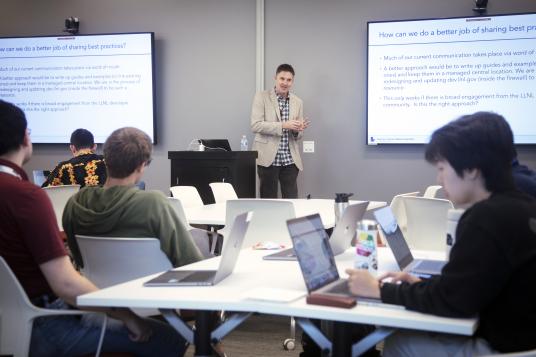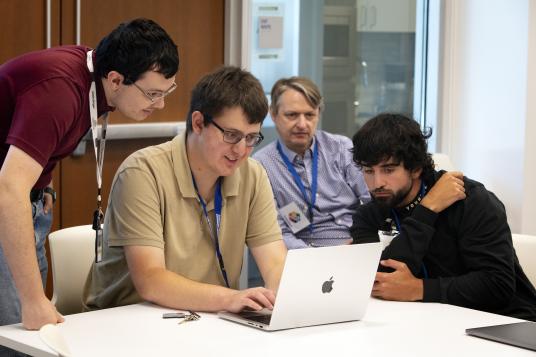Disclaimer: This article is more than two years old. Developments in science and computing happen quickly, and more up-to-date resources on this topic may be available.
More than 50 employees and summer interns joined together at the Livermore Valley Open Campus on July 7 and 8 for the summer 2023 seasonal hackathon.
In his opening remarks, keynote speaker Erik Draeger emphasized the important role hackathons play in software innovation and collaboration. He noted the software world changes fast, and hackathons provide a place to work together to explore new ideas, share best practices, and discover useful tools.
“What you are doing is fantastic. If we can all learn from each other, we can do things even more fantastically,” said Draeger, who serves as director of LLNL’s High Performance Computing Innovation Center.
This season’s hackathon featured a balance between work projects and personal projects. Summer interns, in particular, focused on improving life at the Lab.
One improvement came from interns Yu Pan, Anh Tran, and Peter LaMantia, who say the Lab’s 1,470 acronyms create “confusion for newbies” during their onboarding process. They focused their time on creating a somewhat tongue-in-cheek acronym flashcard game.
“You hear about this problem all the time, so we might as well take it to the extreme and do something about it,” said Pan.
Their game quizzes users on whether or not a given phrase is a real Lab acronym, and provides its meaning if it is. They envision its use as something similar to Kahoot, “a fun game you can play to have a good laugh,” said Tran.
Sitting next to a stack of board games (he didn’t bring them), Chris Webster—a regular Computing hackathon attendee—used the time to catch up on work tasks he had been setting aside. “It’s a nice, relaxing environment to change things up and work on something new. I can spend time on what isn’t as high a priority for my projects,” he said.
Webster was one of a handful of people participating in work-related efforts. Others dived into enrichment projects—like Carolyn Albiston, who wrote a Python program to describe projectile motion as part of The Ray Tracer Challenge, a test-driven approach to developing a 3D renderer.
“It seemed like everybody enjoyed themselves and were happy to participate,” said Christopher Moussa, one of the co-organizers. “Being able to host an event in-person makes it all that much more engaging, and we hope everybody who participated got a lot out of it.” Along with Moussa, Collin Kenner, Peter Pirkelbauer, and Giorgis Georgakoudis, from Livermore Computing and the Center for Applied Scientific Computing, co-organized the event.
—Anashe Bandari




